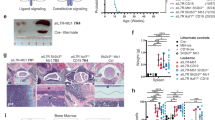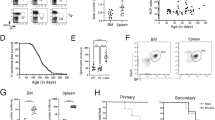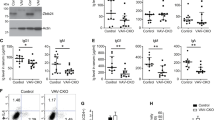Abstract
A common feature of B-cell chronic lymphocytic leukemia (CLL) is chromosomal loss of 13q14, containing the miR15a/16-1 locus controlling B-cell proliferation. However, CLL etiology remains unclear. CLL is an adult leukemia with an incidence that increases with advancing age. A unique feature of CLL is biased B-cell antigen receptor (BCR) usage, autoreactivity with polyreactivity and CD5 expression, all suggest a role for the BCR in driving CLL pathogenesis. Among human CLLs, BCRs autoreactive with non-muscle myosin IIA (AMyIIA) are recurrent. Here we identify an unmutated AMyIIA BCR in mouse, with distinctive CDR3 segments capable of promoting leukemogenesis. B cells with this AMyIIA BCR are generated by BCR-dependent signaling during B-1 fetal/neonatal development with CD5 induction, but not in adults. These early-generated AMyIIA B-1 B cells self-renew, increase during aging and can progress to become monoclonal B-cell lymphocytosis, followed by aggressive CLL in aged mice, often with the loss of a chromosomal region containing the miR15a/16-1 locus of varying length, as in human CLL. Thus, the ability to generate this defined autoreactive BCR by B-1 B cells is a key predisposing step in mice, promoting progression to chronic leukemia.
This is a preview of subscription content, access via your institution
Access options
Subscribe to this journal
Receive 12 print issues and online access
$259.00 per year
only $21.58 per issue
Buy this article
- Purchase on Springer Link
- Instant access to full article PDF
Prices may be subject to local taxes which are calculated during checkout







Similar content being viewed by others
References
Chiorazzi N, Ferrarini M . B cell chronic lymphocytic leukemia: lessons learned from studies of the B cell antigen receptor. Annu Rev Immunol 2003; 21: 841–894.
Fais F, Ghiotto F, Hashimoto S, Sellars B, Valetto A, Allen SL et al. Chronic lymphocytic leukemia B cells express restricted sets of mutated and unmutated antigen receptors. J Clin Invest 1998; 102: 1515–1525.
Damle RN, Wasil T, Fais F, Ghiotto F, Valetto A, Allen SL et al. Ig V gene mutation status and CD38 expression as novel prognostic indicators in chronic lymphocytic leukemia. Blood 1999; 94: 1840–1847.
Hamblin TJ, Davis Z, Gardiner A, Oscier DG, Stevenson FK . Unmutated Ig V(H) genes are associated with a more aggressive form of chronic lymphocytic leukemia. Blood 1999; 94: 1848–1854.
Herve M, Xu K, Ng YS, Wardemann H, Albesiano E, Messmer BT et al. Unmutated and mutated chronic lymphocytic leukemias derive from self-reactive B cell precursors despite expressing different antibody reactivity. J Clin Invest 2005; 115: 1636–1643.
Kipps TJ, Carson DA . Autoantibodies in chronic lymphocytic leukemia and related systemic autoimmune diseases. Blood 1993; 81: 2475–2487.
Chu CC, Catera R, Hatzi K, Yan XJ, Zhang L, Wang XB et al. Chronic lymphocytic leukemia antibodies with a common stereotypic rearrangement recognize nonmuscle myosin heavy chain IIA. Blood 2008; 112: 5122–5129.
Widhopf GF 2nd, Rassenti LZ, Toy TL, Gribben JG, Wierda WG, Kipps TJ . Chronic lymphocytic leukemia B cells of more than 1% of patients express virtually identical immunoglobulins. Blood 2004; 104: 2499–2504.
Chu CC, Catera R, Zhang L, Didier S, Agagnina BM, Damle RN et al. Many chronic lymphocytic leukemia antibodies recognize apoptotic cells with exposed nonmuscle myosin heavy chain IIA: implications for patient outcome and cell of origin. Blood 2010; 115: 3907–3915.
Lanemo Myhrinder A, Hellqvist E, Sidorova E, Soderberg A, Baxendale H, Dahle C et al. A new perspective: molecular motifs on oxidized LDL, apoptotic cells, and bacteria are targets for chronic lymphocytic leukemia antibodies. Blood 2008; 111: 3838–3848.
Chiorazzi N, Ferrarini M . Cellular origin(s) of chronic lymphocytic leukemia: cautionary notes and additional considerations and possibilities. Blood 2011; 117: 1781–1791.
Martin T, Duffy SF, Carson DA, Kipps TJ . Evidence for somatic selection of natural autoantibodies. J Exp Med 1992; 175: 983–991.
Hardy RR, Hayakawa K . B cell development pathways. Annu Rev Immunol 2001; 19: 595–621.
Hayakawa K, Asano M, Shinton SA, Gui M, Allman D, Stewart CL et al. Positive selection of natural autoreactive B cells. Science 1999; 285: 113–116.
Wen L, Brill-Dashoff J, Shinton SA, Asano M, Hardy RR, Hayakawa K . Evidence of marginal-zone B cell-positive selection in spleen. Immunity 2005; 23: 297–308.
Hardy RR, Hayakawa K . A developmental switch in B lymphopoiesis. Proc Natl Acad Sci USA 1991; 88: 11550–11554.
Yuan J, Nguyen CK, Liu X, Kanellopoulou C, Muljo SA . Lin28b reprograms adult bone marrow hematopoietic progenitors to mediate fetal-like lymphopoiesis. Science 2012; 335: 1195–1200.
Zhou Y, Li YS, Rao Bandi S, Tang L, Shinton SA, Hayakawa K et al. Lin28b promotes fetal B lymphopoiesis through the transcription factor Arid3a. J Exp Med 2015; 212: 569–580.
Hayakawa K, Hardy RR, Herzenberg LA . Progenitors for Ly-1 B cells are distinct from progenitors for other B cells. J Exp Med 1985; 161: 1554–1568.
Hayakawa K, Hardy RR, Stall AM, Herzenberg LA . Immunoglobulin-bearing B cells reconstitute and maintain the murine Ly-1 B cell lineage. Eur J Immunol 1986; 16: 1313–1316.
Bichi R, Shinton SA, Martin ES, Koval A, Calin GA, Cesari R et al. Human chronic lymphocytic leukemia modeled in mouse by targeted TCL1 expression. Proc Natl Acad Sci USA 2002; 99: 6955–6960.
Morse HC 3rd, Anver MR, Fredrickson TN, Haines DC, Harris AW, Harris NL et al. Bethesda proposals for classification of lymphoid neoplasms in mice. Blood 2002; 100: 246–258.
Johnston CM, Wood AL, Bolland DJ, Corcoran AE . Complete sequence assembly and characterization of the C57BL/6 mouse Ig heavy chain V region. J Immunol 2006; 176: 4221–4234.
Winter DB, Diamond ME, Abu-hadid M, Falkenberg S, Bankert RB . Allelic differences in the VHOx-1 gene explain the absence of a B cell clonal dominance in the primary response of C57BL/6 mice to phthalate. J Immunol 1995; 155: 2445–2452.
Thiebe R, Schable KF, Bensch A, Brensing-Kuppers J, Heim V, Kirschbaum T et al. The variable genes and gene families of the mouse immunoglobulin kappa locus. Eur J Immunol 1999; 29: 2072–2081.
Ichikawa D, Asano M, Shinton SA, Brill-Dashoff J, Formica AM, Velcich A et al. Natural Anti-Intestinal Goblet Cell Autoantibody Production from Marginal Zone B Cells. J Immunol 2015; 194: 606–614.
Wen L, Shinton SA, Hardy RR, Hayakawa K . Association of B-1 B cells with follicular dendritic cells in spleen. J Immunol 2005; 174: 6918–6926.
Winkler TH, Rolink A, Melchers F, Karasuyama H . Precursor B cells of mouse bone marrow express two different complexes with the surrogate light chain on the surface. Eur J Immunol 1995; 25: 446–450.
Yan XJ, Albesiano E, Zanesi N, Yancopoulos S, Sawyer A, Romano E et al. B cell receptors in TCL1 transgenic mice resemble those of aggressive, treatment-resistant human chronic lymphocytic leukemia. Proc Natl Acad Sci USA 2006; 103: 11713–11718.
Klein U, Lia M, Crespo M, Siegel R, Shen Q, Mo T et al. The DLEU2/miR-15a/16-1 cluster controls B cell proliferation and its deletion leads to chronic lymphocytic leukemia. Cancer Cell 2010; 17: 28–40.
Dohner H, Stilgenbauer S, Benner A, Leupolt E, Krober A, Bullinger L et al. Genomic aberrations and survival in chronic lymphocytic leukemia. N Engl J Med 2000; 343: 1910–1916.
Takeda K, Yu ZX, Qian S, Chin TK, Adelstein RS, Ferrans VJ . Nonmuscle myosin II localizes to the Z-lines and intercalated discs of cardiac muscle and to the Z-lines of skeletal muscle. Cell Motil Cytoskeleton 2000; 46: 59–68.
Vicente-Manzanares M, Ma X, Adelstein RS, Horwitz AR . Non-muscle myosin II takes centre stage in cell adhesion and migration. Nat Rev Mol Cell Biol 2009; 10: 778–790.
Li YS, Hayakawa K, Hardy RR . The regulated expression of B lineage associated genes during B cell differentiation in bone marrow and fetal liver. J Exp Med 1993; 178: 951–960.
Wasserman R, Li YS, Shinton SA, Carmack CE, Manser T, Wiest DL et al. A novel mechanism for B cell repertoire maturation based on response by B cell precursors to pre-B receptor assembly. J Exp Med 1998; 187: 259–264.
Hardy RR, Hayakawa K, Shimizu M, Yamasaki K, Kishimoto T . Rheumatoid factor secretion from human Leu-1+ B cells. Science 1987; 236: 81–83.
Mageed RA, MacKenzie LE, Stevenson FK, Yuksel B, Shokri F, Maziak BR et al. Selective expression of a VHIV subfamily of immunoglobulin genes in human CD5+ B lymphocytes from cord blood. J Exp Med 1991; 174: 109–113.
Martin F, Kearney JF . Marginal-zone B cells. Nat Rev Immunol 2002; 2: 323–335.
Ouillette P, Collins R, Shakhan S, Li J, Li C, Shedden K et al. The prognostic significance of various 13q14 deletions in chronic lymphocytic leukemia. Clin Cancer Res 2011; 17: 6778–6790.
Rodig SJ, Shahsafaei A, Li B, Dorfman DM . The CD45 isoform B220 identifies select subsets of human B cells and B-cell lymphoproliferative disorders. Hum Pathol 2005; 36: 51–57.
Seifert M, Sellmann L, Bloehdorn J, Wein F, Stilgenbauer S, Durig J et al. Cellular origin and pathophysiology of chronic lymphocytic leukemia. J Exp Med 2012; 209: 2183–2198.
Krishnan MR, Jou NT, Marion TN . Correlation between the amino acid position of arginine in VH-CDR3 and specificity for native DNA among autoimmune antibodies. J Immunol 1996; 157: 2430–2439.
Duhren-von Minden M, Ubelhart R, Schneider D, Wossning T, Bach MP, Buchner M et al. Chronic lymphocytic leukaemia is driven by antigen-independent cell-autonomous signalling. Nature 2012; 489: 309–312.
Ansel KM, Harris RB, Cyster JG . CXCL13 is required for B1 cell homing, natural antibody production, and body cavity immunity. Immunity 2002; 16: 67–76.
Ha SA, Tsuji M, Suzuki K, Meek B, Yasuda N, Kaisho T et al. Regulation of B1 cell migration by signals through Toll-like receptors. J Exp Med 2006; 203: 2541–2550.
Kim H, Koh GY . Platelets take the lead in lymphatic separation. Circ Res 2010; 106: 1184–1186.
Lia M, Carette A, Tang H, Shen Q, Mo T, Bhagat G et al. Functional dissection of the chromosome 13q14 tumor-suppressor locus using transgenic mouse lines. Blood 2012; 119: 2981–2990.
Klein U, Kuppers R, Rajewsky K . Variable region gene analysis of B cell subsets derived from a 4-year-old child: somatically mutated memory B cells accumulate in the peripheral blood already at young age. J Exp Med 1994; 180: 1383–1393.
Wang X, Stollar BD . Immunoglobulin VH gene expression in human aging. Clin Immunol 1999; 93: 132–142.
Kipps TJ, Tomhave E, Pratt LF, Duffy S, Chen PP, Carson DA . Developmentally restricted immunoglobulin heavy chain variable region gene expressed at high frequency in chronic lymphocytic leukemia. Proc Natl Acad Sci USA 1989; 86: 5913–5917.
Steininger C, Widhopf GF 2nd, Ghia EM, Morello CS, Vanura K, Sanders R et al. Recombinant antibodies encoded by IGHV1-69 react with pUL32, a phosphoprotein of cytomegalovirus and B-cell superantigen. Blood 2012; 119: 2293–2301.
Johnson TA, Rassenti LZ, Kipps TJ . Ig VH1 genes expressed in B cell chronic lymphocytic leukemia exhibit distinctive molecular features. J Immunol 1997; 158: 235–246.
Schroeder HW Jr, Hillson JL, Perlmutter RM . Early restriction of the human antibody repertoire. Science 1987; 238: 791–793.
Murray F, Darzentas N, Hadzidimitriou A, Tobin G, Boudjogra M, Scielzo C et al. Stereotyped patterns of somatic hypermutation in subsets of patients with chronic lymphocytic leukemia: implications for the role of antigen selection in leukemogenesis. Blood 2008; 111: 1524–1533.
Hwang KK, Trama AM, Kozink DM, Chen X, Wiehe K, Cooper AJ et al. IGHV1-69 B cell chronic lymphocytic leukemia antibodies cross-react with HIV-1 and hepatitis C virus antigens as well as intestinal commensal bacteria. PloS ONE 2014; 9: e90725.
Forconi F, Potter KN, Wheatley I, Darzentas N, Sozzi E, Stamatopoulos K et al. The normal IGHV1-69-derived B-cell repertoire contains stereotypic patterns characteristic of unmutated CLL. Blood 2010; 115: 71–77.
Potter KN, Orchard J, Critchley E, Mockridge CI, Jose A, Stevenson FK . Features of the overexpressed V1-69 genes in the unmutated subset of chronic lymphocytic leukemia are distinct from those in the healthy elderly repertoire. Blood 2003; 101: 3082–3084.
Herling M, Patel KA, Khalili J, Schlette E, Kobayashi R, Medeiros LJ et al. TCL1 shows a regulated expression pattern in chronic lymphocytic leukemia that correlates with molecular subtypes and proliferative state. Leukemia 2006; 20: 280–285.
Antin JH, Emerson SG, Martin P, Gadol N, Ault KA . Leu-1+ (CD5+ B cells. A major lymphoid subpopulation in human fetal spleen: phenotypic and functional studies. J Immunol 1986; 136: 505–510.
McWilliams L, Su KY, Liang X, Liao D, Floyd S, Amos J et al. The human fetal lymphocyte lineage: identification by CD27 and LIN28B expression in B cell progenitors. J Leuko Biol 2013; 94: 991–1001.
Acknowledgements
We thank Carlo M. Croce for providing hTCL1 transgenic mice and Y. Nakao for analysis of tumor-bearing mice. Also, we acknowledge several Fox Chase Cancer Center shared facilities for technical support, flow cytometry, DNA sequencing, cell culture, transgenic mouse, laboratory animals and genomics, including J. Pei for CGH. We thank T. Manser and K. Campbell for discussion and comments. This work was supported by the National Institutes of Health (NIH) RO1 CA129330 (KH), R01 AI049335 (KH), RO1 AI026782 (RRH), RC1 CA145445 (RRH and KH), NIH T32 training grant (MJC), and the Fox Chase Cancer Center Blood Cell Development and Cancer Keystone program, and in part by the Intramural Research Program of the NIH, NIAID.
Author information
Authors and Affiliations
Corresponding author
Ethics declarations
Competing interests
The authors declare no conflict of interest.
Additional information
Supplementary Information accompanies this paper on the Leukemia website
Supplementary information
Rights and permissions
About this article
Cite this article
Hayakawa, K., Formica, A., Colombo, M. et al. Loss of a chromosomal region with synteny to human 13q14 occurs in mouse chronic lymphocytic leukemia that originates from early-generated B-1 B cells. Leukemia 30, 1510–1519 (2016). https://doi.org/10.1038/leu.2016.61
Received:
Revised:
Accepted:
Published:
Issue Date:
DOI: https://doi.org/10.1038/leu.2016.61
This article is cited by
-
Pla2g2a promotes innate Th2-type immunity lymphocytes to increase B1a cells
Scientific Reports (2022)
-
CTLA-4 expression by B-1a B cells is essential for immune tolerance
Nature Communications (2021)
-
Nfkbie-deficiency leads to increased susceptibility to develop B-cell lymphoproliferative disorders in aged mice
Blood Cancer Journal (2020)
-
Pathophysiology of chronic lymphocytic leukemia and human B1 cell development
International Journal of Hematology (2020)
-
Role of Bruton’s tyrosine kinase in B cells and malignancies
Molecular Cancer (2018)



